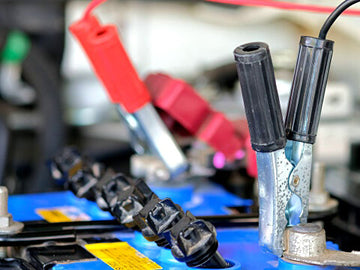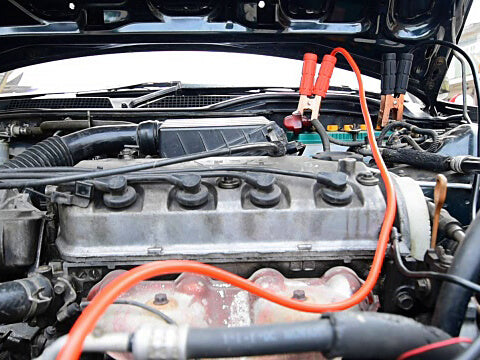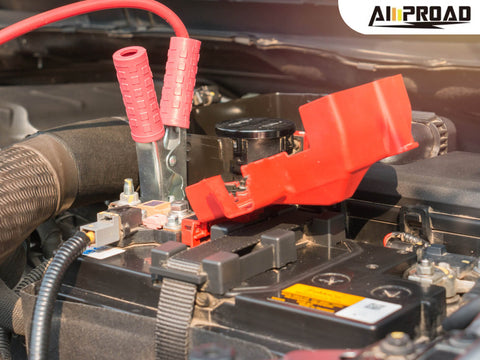
Are you stranded with a dead battery in your SUV? Don't panic! With a portable jump starter, you can quickly get back on the road without relying on another vehicle for assistance. In this guide, we'll walk you through the simple steps of using a portable jump starter to boost your SUV safely and efficiently.
First, we'll cover essential safety precautions to ensure your well-being and protect your vehicle from damage. Then, we'll show you how to locate your SUV's battery and connect the portable jump starter properly. You'll learn the correct procedure for starting your SUV using the jump starter and how to handle it afterward. With our expert tips, you'll gain the confidence to handle battery emergencies with ease and get back to your journey in no time.
What safety precautions should I take before using a portable jump starter on my SUV?
Before using a portable jump starter on your SUV, it's crucial to prioritize safety. Here are some essential precautions to keep in mind:
- Read the Manual: Familiarize yourself with the instructions provided by the manufacturer of the portable jump starter. Each device may have specific guidelines and safety precautions.
- Inspect the Jump Starter: Before connecting it to your SUV's battery, check the portable jump starter for any visible damage, such as cracks or exposed wires. Using a damaged jump starter can pose a safety risk.
- Ensure Proper Ventilation: Move your SUV to a well-ventilated area, preferably outdoors, to minimize the risk of gas buildup and exposure to harmful fumes emitted during the jump-starting process.
- Turn Off Ignition and Electronics: Ensure that the ignition and all electronic devices in your SUV are turned off before connecting the jump starter. This prevents the risk of electrical sparks and damage to sensitive electronic components.
- Wear Protective Gear: Wear safety gloves and eye protection to shield yourself from any potential hazards, such as battery acid or sparks, during the jump-starting process.
- Follow Correct Polarity: Pay close attention to the positive (+) and negative (-) terminals on both the battery booster pack and your SUV's battery. Improper connection can result in damage to the vehicle's electrical system.
By adhering to these safety precautions, you can minimize the risk of accidents and ensure a smooth and safe jump-starting process for your SUV. Remember, safety always comes first when dealing with automotive batteries and electrical systems.
How do I locate the battery in my SUV and access it for jump starting?

Locating and accessing the battery in your SUV is the first step to jump-starting it safely. Here's how you can find and access the battery:
- Consult the Owner's Manual: The owner's manual of your SUV will provide detailed instructions on the location of the battery. It may be located under the hood, in the trunk, or in a specific compartment.
- Open the Hood or Access Panel: If the battery is located under the hood, release the hood latch inside your SUV and prop open the hood securely. If it's in the trunk or another compartment, locate the access panel and open it carefully.
- Identify the Battery: Once you have access to the battery, visually inspect it to identify the positive (+) and negative (-) terminals. They are usually labeled with symbols or signs, but if not, the positive terminal is typically larger and may have a red cover or marking.
- Clear any Obstructions: Before connecting the jump starter, ensure there are no obstructions around the battery that may interfere with the connection or pose a safety hazard.
- Position the Jump Starter: Place the portable battery booster near the battery, ensuring the cables can reach both the positive and negative terminals without strain. Keep the jump starter away from moving parts and hot surfaces to prevent damage.
By following these steps, you can easily locate the battery in your SUV and prepare it for jump-starting. Remember to exercise caution and follow safety precautions throughout the process to avoid accidents or damage to your vehicle.
How to boost my SUV using the portable jump starter?
Though, boosting your SUV using a portable jump starter is a straightforward process, knowing how to boost a car properly is still essential. Here's a step-by-step guide to help you get your vehicle up and running:
- Prepare the Jump Starter: Ensure that the portable jump starter is fully charged and switched off before use. Double-check the connections and make sure there are no loose cables or visible damage.
- Position the Vehicles: Park the vehicle with the dead battery (your SUV) and the vehicle providing the jump (the donor vehicle or another car with a functional battery) close enough for the jumper cables to reach but without the vehicles touching each other.
- Turn Off Ignition: Turn off the ignition, lights, and any other electrical devices in both vehicles to prevent sparks and potential damage during the jump-starting process.
- Connect the Jump Starter: Identify the positive (+) and negative (-) terminals on the dead battery in your SUV. Attach the red (positive) clamp of the jumper cables to the positive terminal of the dead battery. Then, attach the black (negative) clamp to a metal surface on the engine block or frame of your SUV. This serves as a ground connection.
- Connect the Donor Vehicle: Connect the other end of the jumper cables to the corresponding terminals of the donor vehicle's battery. Start with the positive clamp and then the negative clamp.
- Start the Donor Vehicle: Start the engine of the donor vehicle and let it run for a few minutes to charge the dead battery in your SUV.
- Start Your SUV: Attempt to start your SUV's engine. If it doesn't start immediately, wait for a few more minutes while keeping the donor vehicle running. Attempt to start your SUV again.
- Disconnect the Jump Starter: Once your SUV starts, carefully disconnect the jumper cables in the reverse order of connection. Start by removing the negative clamp from the ground connection on your SUV, followed by the negative clamp from the donor vehicle, the positive clamp from the donor vehicle, and finally the positive clamp from your SUV.
By following these steps, you can safely and effectively boost your SUV using a portable jump starter. Remember to exercise caution and follow the manufacturer's instructions for your specific jump starter model.
How long should I let the engine run after successfully jump starting my SUV?

After successfully jump-starting your SUV, it's essential to allow the engine to run for a sufficient amount of time to ensure that the battery is adequately charged. Here's what you should keep in mind:
- Charging Time: It's recommended to let the engine run for at least 15 to 30 minutes after jump-starting your SUV. This allows the alternator to recharge the battery fully.
- Monitor Battery Voltage: Keep an eye on the voltage gauge or battery indicator on your dashboard. Ideally, the voltage should return to normal levels within this timeframe, indicating that the battery is charging properly.
- Avoid Short Trips: If possible, avoid short trips immediately after jump-starting your SUV. Opt for a longer drive to allow the battery to recharge fully. Short trips may not provide sufficient time for the alternator to replenish the battery's charge.
- Battery Health: Consider the age and condition of your SUV's battery. If it's an older battery or has shown signs of weakness, you may need to let the engine run for a longer period to ensure adequate charging.
- Professional Inspection: If you frequently experience dead battery issues or if the battery fails to hold a charge after jump-starting, it may indicate underlying issues with the battery or charging system. In such cases, it's advisable to have your SUV inspected by a professional mechanic to diagnose and address any potential problems.
By allowing the engine to run for the recommended duration after jump-starting your SUV, you can ensure that the battery is sufficiently charged and ready for your next journey.
What should I do with the portable jump starter once I've finished jump starting my SUV?
Once you've successfully jump-started your SUV using the AMPROAD versatile portable jump starter (if any), it's essential to follow these steps:
- Turn Off and Disconnect: Switch off the portable jump starter and disconnect it from your SUV's battery. Ensure that all cables are safely removed to prevent any accidental electrical contact.
- Store Safely: Store the battery booster in a cool, dry place away from direct sunlight and extreme temperatures. This helps prolong its lifespan and ensures it's ready for future use.
- Recharge if Needed: If the jump starter's battery has been partially or fully depleted during the jump-starting process, recharge it as soon as possible to maintain its readiness for emergencies.
- Inspect for Damage: Periodically inspect the portable jump starter for any signs of damage, such as cracks, leaks, or corrosion. If you notice any issues, discontinue use and seek professional assistance or replacement.
By following these simple steps, you can ensure that your portable jump starter remains in good condition and ready to assist you whenever you encounter a dead battery in your SUV.
How can I properly store and maintain my portable jump starter for future use?
Once you've successfully jump-started your SUV using the AMPROAD versatile portable jump starter, it's essential to follow these steps:
- Turn Off and Disconnect: Switch off the portable jump starter and disconnect it from your SUV's battery. Ensure that all cables are safely removed to prevent any accidental electrical contact.
- Store Safely: Store the jump starter in a cool, dry place away from direct sunlight and extreme temperatures. This helps prolong its lifespan and ensures it's ready for future use.
- Recharge if Needed: If the jump starter's battery has been partially or fully depleted during the jump-starting process, recharge it as soon as possible to maintain its readiness for emergencies.
- Inspect for Damage: Periodically inspect the portable jump starter for any signs of damage, such as cracks, leaks, or corrosion. If you notice any issues, discontinue use and seek professional assistance or replacement.
By following these simple steps, you can ensure that your portable jump starter remains in good condition and ready to assist you whenever you encounter a dead battery in your SUV.
FAQs / People Also Ask
Q: Is it safe to use a portable jump starter on my SUV?
A: Yes, using a portable jump starter is safe as long as you follow the manufacturer's instructions and safety precautions provided in the user manual.
Q: How do I know if my SUV's battery needs a jump start?
A: Signs that your SUV's battery may need a jump start include dim headlights, difficulty starting the engine, and clicking sounds when you turn the key.
Q: Can I use any portable jump starter on my SUV?
A: It's essential to use a portable jump starter that is compatible with your SUV's battery size and type. Consult your vehicle's manual or the jump starter manufacturer's guidelines for compatibility.
Q: How long does it take to charge a dead battery with a portable jump starter?
A: The time it takes to charge a dead battery depends on various factors, including the battery's condition and the capacity of the jump starter. In general, it may take a few minutes to start the vehicle, but it's advisable to let the engine run for 15 to 30 minutes to fully recharge the battery.
Q: Can I use a portable jump starter on other vehicles besides my SUV?
A: Yes, portable jump starters are versatile and can be used on a variety of vehicles, including cars, trucks, motorcycles, and boats, as long as the voltage and polarity match the vehicle's battery requirements.
Q: What should I do if the portable jump starter doesn't work?
A: If the portable jump starter fails to start your SUV, double-check the connections, ensure the jump starter is fully charged, and try again. If it still doesn't work, seek professional assistance or consider replacing the jump starter.


